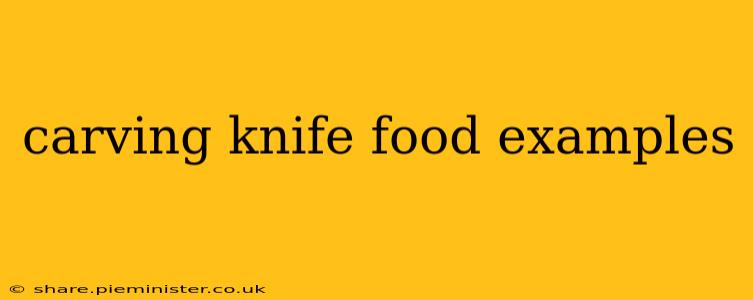A sharp carving knife is a kitchen essential, transforming the experience of serving a beautifully cooked roast or intricately slicing delicate fish. But its applications extend far beyond just meats; the right carving knife can elevate your presentation and enjoyment of a wide variety of foods. This guide explores various food examples perfect for a carving knife, highlighting techniques and considerations for optimal results.
What Foods Can You Use a Carving Knife On?
The versatility of a carving knife allows it to tackle a surprising array of food items. While it's best known for meats, its long, thin blade and sharp point are equally suited to:
-
Roasted Meats: This is the quintessential use case. Think succulent roasts like beef, pork, lamb, and turkey. The long blade allows for clean, even slices, minimizing tearing and maximizing visual appeal.
-
Poultry: Chicken, duck, and goose all benefit from the precision of a carving knife. You can easily separate breasts from legs and carve thin, elegant slices.
-
Fish: Delicate fish fillets, like salmon or sea bass, require a gentle touch. A sharp carving knife enables you to create beautiful slices without shredding the fish.
-
Baked Ham: A carving knife is ideal for slicing ham evenly, whether it's a bone-in or boneless roast.
-
Large Vegetables: While not as common, a carving knife can be used to carve large vegetables like roasted squash or pumpkins for impressive presentations.
-
Fruit: Certain fruits, such as watermelon or pineapple, can be carved with a sharp carving knife to create interesting shapes and garnishes.
What are the Best Cuts of Meat to Carve with a Carving Knife?
Some cuts of meat are particularly well-suited to carving with a knife. These include:
-
Prime Rib Roast: The even texture of a prime rib makes it easy to carve thin, consistent slices.
-
Standing Rib Roast: Similar to prime rib, the standing rib roast allows for impressive presentation and easy carving.
-
Roast Chicken: A whole roasted chicken is a classic example of a dish perfect for a carving knife, enabling you to separate the breast, legs, and thighs with precision.
How to Properly Use a Carving Knife for Different Foods?
The technique for using a carving knife varies slightly depending on the food. However, some general principles apply:
-
Sharpness is Key: A dull knife will tear and shred the food, ruining both presentation and texture. Always ensure your knife is sharp before you begin.
-
Stabilize the Food: Use a carving fork to hold the meat securely in place while you carve.
-
Slice Against the Grain: For meats, slicing against the grain results in more tender slices.
-
Even Slices: Aim for consistent slice thickness for even cooking and a more appealing presentation.
-
Gentle Pressure: Avoid applying excessive force, which can damage the knife and the food.
What are Some Tips for Carving Meat with a Carving Knife?
-
Let the Meat Rest: Allow roasted meats to rest for at least 15-20 minutes before carving. This allows the juices to redistribute, resulting in more tender and flavorful slices.
-
Use a Carving Fork: A carving fork keeps the meat steady and prevents it from moving around while you carve.
-
Start with the Thicker Parts: Begin carving from the thickest part of the meat and work your way towards the thinner sections.
What are Some Alternatives to a Carving Knife for Certain Foods?
While a carving knife excels at many tasks, there are times when other tools might be more suitable:
-
Electric Knife: For large roasts or very tough meats, an electric knife can make the process easier and faster.
-
Butcher Knife: For breaking down large cuts of meat before carving, a butcher knife is a powerful tool.
-
Boning Knife: A boning knife is better for separating meat from bone than a carving knife.
By understanding the versatility of a carving knife and employing the proper techniques, you can elevate your culinary skills and create stunning, delicious presentations for a variety of foods. Remember, a sharp knife is your best friend in the kitchen.
